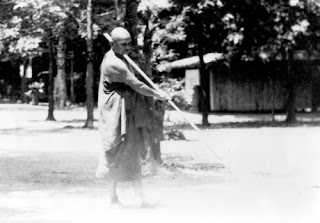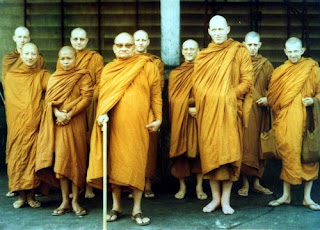The wonderfully wise Ajahn Chah
The venerable Ajahn Chah (1918-1992) was a great & wise monk who lived most of his life as a forest monk in Ubon Ratchathani in Northeast Thailand. He taught thousands of people, Thai & foreigner alike; monks, nuns, and laity gathered to listen to his insightful talks on the Dharma. Many of these talks have been collected into books, and translated into several different languages (he taught in Thai & Isan, the latter a fusion of Thai & Lao spoken in Northeast Thailand). The excerpts in bold found interspersed with photographs in this article are from one such book called 'No Ajahn Chah;' a link to it in PDF format is at the bottom of this post, along with a link to the gallery from where the photos were obtained (all free).
I did not have the pleasure of meeting Ajahn Chah, but have learned (and unlearned) much from reading translations of his wise Dharma talks. I have also met people who knew him, including Ajahn Sumedho, his most senior foreign (non-Thai) disciple, along with other forest monks. Living in Ubon Ratchthani, I have the opportunity to visit Ajahn Chah's main monastery, Wat Nong Pah Pong, which lies just outside the city in a small forest. There are now monasteries all over the world in the lineage of Ajahn Chah, in countries such as America, Britain, Australia, New Zealand, Canada, Italy, and Switzerland, as well as many in his native Thailand.
January 16th this year was the twentieth anniversary of Ajahn Chah's death, and, as with every year, there was a gathering of monks, nuns, and laity at Wat Nong Pah Pong to commemorate his life & teachings. It can be a moving experience to share food, chant, meditate, and talk with so many others who felt inspired to one degree or another by this great monk. And yet, reading & reflecting on the book that is quoted below, it's enlightening to recall that ultimately there was no Ajahn Chah, as he once said himself, but rather natural processes arising and falling away in emptiness. And this is true for me and for you, too, dear reader; isn't it?
When one does not understand death, life can be very confusing.
The Buddha told his disciple Ananda to see impermanence, to see death with every breath. We must know death; we must die in order to live. What does this mean? To die is to come to the end of all our doubts, all our questions, and just be here with the present reality. You can never die tomorrow; you must die now. Can you do it? If you can do it, you will know the peace of no more questions.
Ajahn Chah sweeping the monastery grounds
If our body really belonged to us, it would obey our commands. If we say "Don’t get old," or “I forbid you to get sick," does it obey us? No! It’s take no notice, We only rent this "house," not own it. If we think it does belong to us, we will suffer when we have to leave it. But in reality, there is no such thing as a permanent self, nothing un- changing or solid that we can hold on to.
Regardless of time and place, the whole practice of Dharma comes to completion at the place where there is nothing. It’s the place of surrender, of emptiness, of laying down the burden. This is the finish.
Conditions all go their own natural way. Whether we laugh or cry over them, they just go their own way. And there is no knowledge of science which can prevent this natural course of things. You may get a dentist to look at your teeth, but even if they can fix them, they still finally go their natural way. Eventually even the dentist has the same trouble. Everything fall apart in the end.
Ajahn Chah feeding a fellow inhabitant of the forest
When those who do not understand the Dharma act improperly, they look all around to make sure no one is watching. But our karma is always watching. We never really get away with anything.
Remember you don’t meditate to get anything, but to get rid of things. We do it not with desire but with letting go. If you want anything, you won’t find it.
The real foundation of the teaching is to see the self a being empty. But people come to study the Dharma to increase their self-view, so they don’t want to experience suffering or difficulty. They want everything to be cosy. They may want to transcend suffering, but if there is still a self, how can they ever do so?
Ajahn Chah & some western monks under his guidance
(The famous Ajahn Sumedho is the tall one on the right.)
If you let go a little, you will have a little peace. If you let go a lot, you will have a lot of peace. If you let go completely, you will have complete peace.
Anyone can build a house of wood and bricks, but the Buddha taught us that sort of home is not our real home. It’s a home in the world and it follows the ways of the world. Our real home is inner peace.
Ajahn Chah became increasingly frail over the years
If you see certainty in that which is uncertain, you are bound to suffer.
You are your own teacher. Looking for teachers can’t solve your own doubts. Investigate yourself to find the truth – inside, not outside. Knowing yourself is most important.
The last decade of his life he couldn't speak or walk
No one and nothing can free you but your own understanding.
Look after your virtue as a gardener takes care of his plants. Do not be attached to big or small, important or unimportant. Some people want shortcuts. They say, "Forget concentration, we’ll go straight to in- sight; forget virtue, we’ll start with concentration." We have so many excuses for our attachments.
Ajahn Sumedho (centre) & other monks at Ajahn Chah's funeral
The Buddha taught to lay down those things that lack a real abiding essence. If you lay everything down you will see the truth. If you don’t, you won’t. That’s the way it is. And when wisdom awakens within you, you will see truth wherever you look. Truth is all you’ll see.
The above quotations are excerpted from the book 'No Ajahn Chah' which is available to view or download at the following link: No Ajahn Chah
The photographs of Ajahn Chah are taken from the following site, where there are many more wonderful images of him: Ajahn Chah Photo Gallery









5 comments:
Thank you so very much for sharing these beautiful pictures along with the information and the links that I was able to go to, for I really enjoyed this!
Wonderful! His book "A Still Forest Pool" is easily the most helpful dharma book I've ever read. It's pure gold.
Thanks immensely to you who have posted these priceless expressions Of Ajahn Chah ,which are powerful enough to make a meritorious individual make a constant meditater .
Thank you foR taking the time to leave your message, Uthapada Thithi Bhanga. We are truly fortunate to possess Ajahn Chah's wonderful teachings.
Thanks to Now and mwiseley, too!
Glad you enjoyed the post & links, Now.
Yes, 'A Still Forest Pool' was the book that introduced me to Ajahn Chah many moons ago. Still flick through it from time to time.
Post a Comment